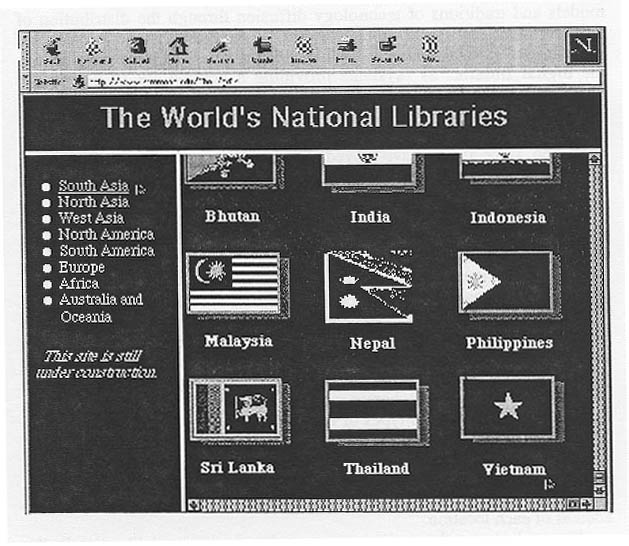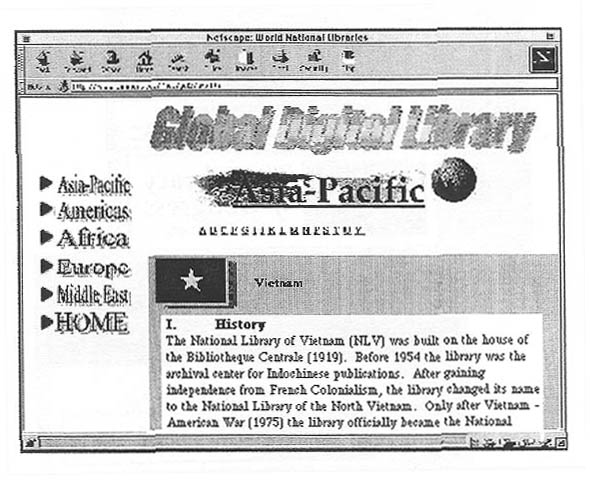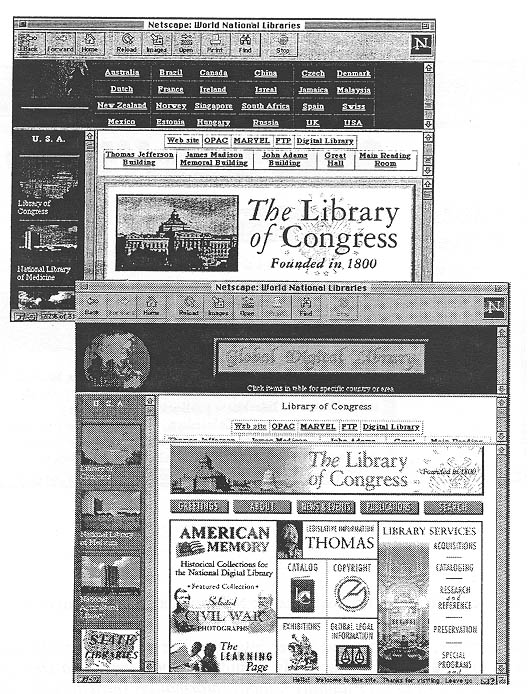
Figure 1. Accessing the World's National Libraries via GDL

Figure 2. Retrieving Information on the National Library of Vietnam via GDL
GLOBAL DIGITAL LIBRARY: Can the Technology Havenots Claim A Place in Cyberspace?
Ching-chih Chen
Graduate School of Library and Information Science
Simmons College
Boston, MA 02115, USA
E-mail: cchen@simmons.edu
For over ten years I have advocated the coming of global digital libraries (GDL) and discussed the challenges for libraries and librarians (Chen, 1993; 1994; 1995b; 1996a; 1996b). As NIT is coming to Vietnam, a new country on the NIT map, I would like to take this chance to discuss the GDL concept again fully realizing that many of our library colleagues here still do not have quick access to Internet and Web Wide Web.
In the latest few years, the fast-paced development in the expanded use of the Internet for digital publishing on the World Wide Web (WWW) for both commercial and noncommercial purposes has been explosive. Clearly, with the ability for us to talk, write, confer with, or send textual, audio and visual information to anyone else in any part of the world, the landscape for information and for library and information services provision and delivery has changed dramatically. In addition of talking about library networking and automation in the more traditional sense, we are talking about the reality of digital libraries, and the access and delivery of information over cyberspace in big ways (Chen, 1995a, p. ix).
Hayes (1998) in his excellent review for NIT '98 on the development of library automation in the U.S. in the last nearly 50 years also attempts to predict the development in the coming five years, 1998-2002. He asserts that the information technology will continue to grow at phenomenal rates, and specifically the future developments in the role of software will have even greater impact than those we have seen to date with hardware. The ability for one to be able to fully benefit from the development will depend upon the available technological infrastructure - the telecommunication system and the availability of inexpensive but powerful computers - and the capability to use it. Thus the gap between the "haves'" and the "have-nots" will grow, not decrease. As to libraries, his view is that libraries will continue to be essential in the foreseeable future, but they will absorb the new technologies to make them more economic and effective. They will continue to exist and to pay important historic leadership role in the coming decades. While electronic publication will be increasingly important, it will not replace print in the foreseeable future. And libraries will be the means of access to both print and electronic formats.
2. SIGNIFICANT CONSIDERATIONS FOR LIBRARIES
My own view on the future of the libraries is very much in agreement with Hayes'. It is important to stress that as an advocate of GDL, I have not implied the diminishing importance of the library. Quite contrarily, it is precisely because of the importance of the library -- "information is power" and library is the key provider of information - we need to place everything in the right perspective in light of the current digital environment.
Libraries at all difference levels need to do a great deal of soul-searching. While technological considerations are significant, they may be the least troublesome area. Conceptual, social, legal, and logistical considerations will be far more difficult and complex, and will demand our close attention. What are these considerations? I shall try to provide only a few examples to start our dialog:
• We need to know that the society is moving toward the global economy. At this time, one's ability to obtain information has quickly and largely expanded, particularly through the use of open systems like Internet and WWW. Because of the fast development in this area, use of the Internet and WWW for information access should be an important part of library reference work (we see several papers at this meeting addressing this). In this regard, without access to the Internet and WWW, we shall most likely see the widening gap between the haves and the have-nots. But, the much more important and difficult consideration is to be able to both retrieve and contribute to the "substantial" information contents available in the cyberspace. This is one of the topics which we hope to address at this meeting.
• We know that no one organization has the ability to collect high percentage of needed information resources, particularly in light of the current financial limitations. Thus, sharing information resources by using current technology is essential. This was the basis for many earlier development of library networks for resource sharing, and is still the basis for current development. The only difference is that some of the current ones are talking about sharing resources in using the available global open systems. The pre-requisite for this is the availability of "digital" resources to share. As I talked about GDL, it is no more than a global resource-sharing open system, much like what is already operational in the electronic commerce and entertainment domains. But, the GDL for libraries is asking for "CONTENT" or "KNOWLEDGE BASE". Who is going to provide those will be a very significant question.
• GDL has no boundary, but logistically it is best at this point to think from the country level. For example, it is important to realize that no country -- regardless how developed or not developed, how rich or poor -- have the ability to possess information resources of the global significance. Each needs to consider its responsibility in contributing to the GDL. In order to be able to share, standards and infrastructure issues will be vital.
• Legal issues are significant and deserve serious considerations. These include security, copyright, intellectual properties, sharing in cyberspace without borders, etc... While many of these are issues beyond our ability to address, we still need to be aware of the implications of the provision and use of information in cyberspace.
• Preservation issues in the digital environment need to be explored. What should be preserved and how we can do it best?
At the present time, we do not have a clear "theory" of digital libraries. In literature and speeches, we do not have a well defined definition of a digital library. Because of the simple definition such as that given by Lesk (1997) -- A digital library is a collection of information that is both digitized and organized, we can understand why there are so many different definitions ranging from a digital collection of digitized books, journals, reports, or photo collections to something more complex ones in network-based collaborative knowledge environment.
Yet, they all share some common characteristics (Lesk, 1997):
• A digital library can be searched,
• A digital library can be accessed all over the world,
• A digital library can be copied without error,
Thus a digital library addresses traditional problems of finding information, of delivering it to users, and of preserving it for the future. In dealing with these, we need to know that the digital library must have CONTENT, and content must be properly stored, organized, so that it can be found or retrieved.
When comparing these with what we do in the more traditional library settings, we found remarkably similar process but in very different context.
4. DIGITAL LIBRARY AND DEVELOPING COUNTRIES
Although it is most likely that the development of digital libraries will be slow in developing countries, it is important to know that because of the growing popularity of the Internet open system, and also the ownership of those contents which are country specific, there are great potentials for developing countries to be connected digitally and benefit from various digital library collections available globally.
In order to claim a place in this development, it is important for libraries in developing countries to pay utmost attention to all types of international standards which libraries use in storing and organizing information, in creating digital databases and digital files, and developing retrieval systems. I am pleased that there are a number of papers in this conference addressing these topics.
The planning and creating of proper information infrastructure is also essential. Alexandria Declaration of Principles (Chen, 1995...) can provide be a useful guide to us in this regard.
As libraries begin to create large quantity of digital contents, it is important for us to also pay close attention to the world-wide development in the area of meta-data. A consistent structure has to be developed in order for us to manage and harvest a vast array of multitype information resources.
5. THE NEED FOR INFRASTRUCTURE AND KNOWLEDGE-BASED CONTENTS
As articulated in the IITA Digital Libraries Report, the Internet as a context for deploying digital library systems offers an unprecedented opportunity -- not only technically by providing connectivity to an enormous potential user base, but also culturally, given the Internet community's models and traditions of technology diffusion through the distribution of publicly available prototype software -- to move ahead large-scale experiments" (Lynch & Garcia-Molina, 1996, p. 88). The report also defines the digital libraries as "systems providing a community of users with coherent access to a large, organized repository of information and knowledge" (p. 91).
In line with this definition, and in conjunction with the GDL initiative as described, since 1994 I have moved ahead with an experiment -- creating a seamless GDL prototype, starting with the world's national libraries.
With the easy and widespread use of the Internet and WWW, there are tens of thousands of repositories of digital information available in the cyberspace. Each differs from the other in terms of contents of digital information, depth of contents, style of presentation and user interface. Each also exists to serve diverse purposes and constituencies. Similar differences were found among those national digital libraries accessible via Internet and WWW. Thus, "one of the key challenges is to retain this diversity, which is responsive to unique constituencies," and at the same time, to develop a given digital library system which can "provide a coherent, consistent view of as many of these repositories as possible" by exploring ways in which they can be fused into a coherent whole. The current GDL prototype links the homepages of various types of institutions -- national libraries, national archives, major museums together in one single global digital library system with a coherent and consistent interface. By linking them together in the GDL system, the user community can easily access any site by a simple click of the mouse, without having to search and open the site with the URL address of each location.
Figure 1 shows the preliminary page for the national
libraries in the South Asian region, and by clicking on Vietnam, for example,
one will be able to obtain information on the National Library of Vietnam
(see Figure 2). This exercise shows that the depth of contents for each
national library differs greatly from strictly directional type of homepage
information to very substantial digital library collection such as the
rich digital library collections of the Library of Congress of the U.S.A.,
including that of the American Memory (Figure 3). The GDL prototype system
has demonstrated that provision of universal information access to a large
number of world's digital libraries is technologically feasible. Despite
of the skepticism on the hype and reality of our digital future, one thing
is sure. The technologies are available to enable us to link global information
together to form a GDL for multimedia information delivery. But, there
are many hurdles which we must jump over in order to have a real interoperable
and functionable GDL.

Figure 1. Accessing the World's National Libraries via GDL

Figure 2. Retrieving Information on the National Library of Vietnam via GDL
These barriers, problems and issues related to the effective development of such an GDL are rather extensively included in the Alexandria Declaration of Principles (1995...), Planning Global Information Infrastructure (Chen, 1995a), as well as the IITA Report (Lynch & Garcia-Molina, 1996). These include standards, intellectual properties, copyright language barriers, security, funding, etc..., as stated earlier, and should not be ignored since they are central issues for any international cooperation.

Figure 3. Accessing Library Congress' American Memory via GDL
6. CONCLUSION
While it is certain that we will have the powerful information super-highway -- the Next Generation Internet which will be at least 100 to 1,000 times faster than our current Internet, will be a reality in the near future, but it is very doubtful that we are ready to have sufficient digital contents to utilize this powerful system. Having information sources available in digital format will be the first requirement. Unless information resources are available in digital format, there will be no digital libraries. Once the information sources are available in digital form, they can then be accessed, distributed, and transmitted easily in almost "no" time with "no" cost to the end-users over the global information network, such as Internet. For developing countries, although it is difficult to convert print-based sources to digital files rapidly, creating well-developed databases of useful information resources with internationally accepted standard is a good start toward the eventual partnership in the networked digital environment.
Furthermore, the central concern to the endusers
will have to be the authority and quality of content in digital libraries.
Take the national libraries for example, the GDL prototype experiment informs
us vividly that although there are substantial numbers of national libraries
which have homepages available, most do not have knowledge-based contents.
Instead, they are mainly directional and informational in nature. Thus,
there is a desperate need for quality content building (Chen, 1996a).
REFERENCES
Alexandria Declaration of Principles [prepared by Robert M. Hayes and Ching-chih Chen] (1995). Microcomputers for Information Management, 12 (1-2), 3-8. Reprinted in this Proceedings also.
Chen, Ching-chih. (1993). Technological potentials for the global library: Realities and challenges. In Proceedings of the International Conference on National libraries Towards the 21st Century in Taipei, Taiwan, ROC, April 20-24, 1993 in celebrating the 60th Anniversary of the National Central Library of ROC. Taipei, Taiwan: National Central Library.
Chen, Ching-chih. (1994, September). Information superhighway and the digital global library: Realities and challenges. Microcomputers for Information Management, 11 (3), 143-155.
Chen, Ching-chih, Ed. (1995a). Planning global information infrastructure (518 p.). Norwood, NJ: Ablex.
Chen, Ching-chih. (1995b). Digital global cultural and heritage information network: Personal viewpoint. In Planning Global Information Infrastructure, (pp. 181-185). Ching-chih Chen (Ed.). Norwood, NJ: Ablex.
Chen, Ching-chih. (1996a). "Global digital library: Technology is ready, how about content?" In Proceedings of NIT '96, Pretoria, South Africa, November 11-14, 1996. pp. 41-56.
Chen, Ching-chih. (1996b). "Global digital library initiative: Prototype development and needs," Microcomputers for Information Management, 13 (2), 133-164.
Hayes, Robert M. (1998). "Development of automation of library processes in United States: Historical Review," in this Proceedings.
Lesk, Michael. (1997). Practical Digital Libraries: Books, Bytes, and Bucks. San Francisco, CA: Morgan Kaufmann Publishers.
Lynch, Clifford, and Garcia-Molina, Hector. (1996). "Interoperability, scaling, and the digital libraries research agenda," Microcomputers for Information Management, 13 (2), 85-132.